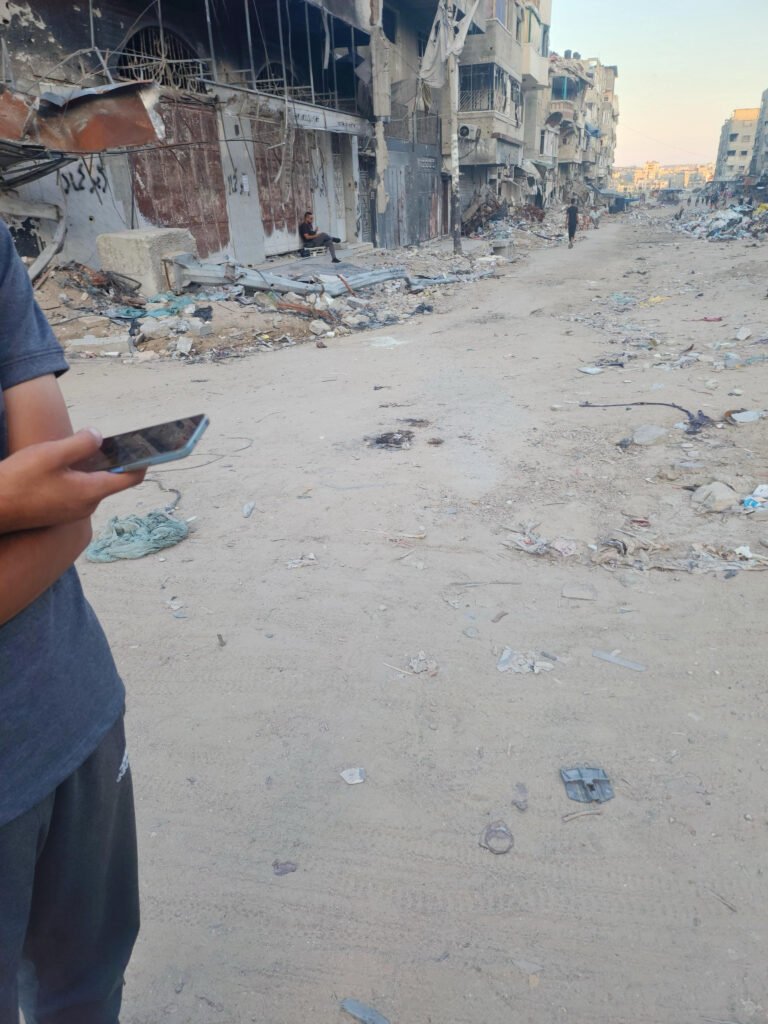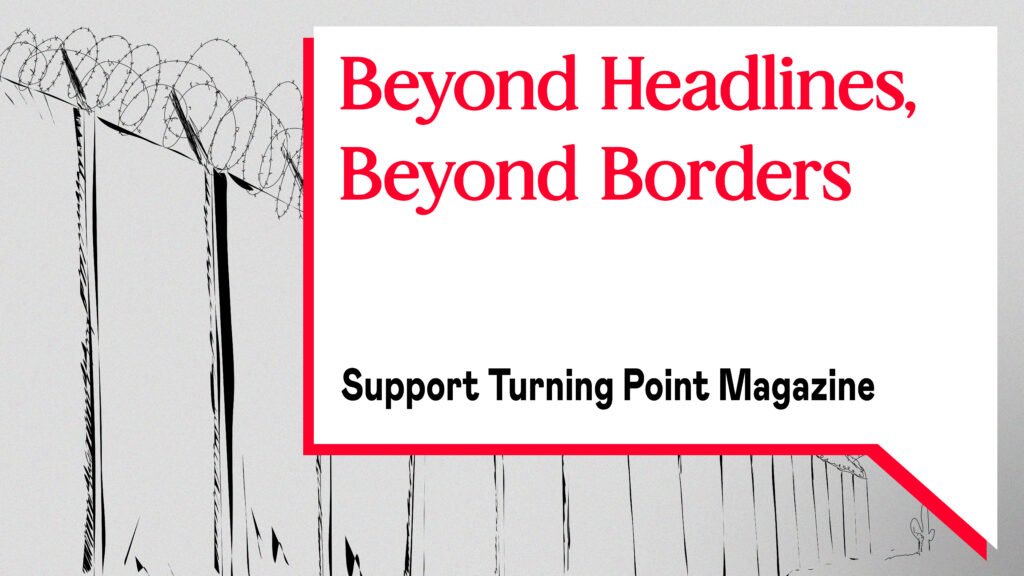Cover photo: Gaza, November 2025: Palestinian journalists in Gaza City are trying to pick up a Wi-Fi signal to continue their work. ©Rizek Abdel Jawad
“I am fine now in Nuseirat. I have a new baby boy, and I named him Hassan.”
– Yousef, a father in Gaza’s Nuseirat refugee camp.
To receive this simple message required the courageous solidarity of dozens of people across two continents. Since October 2023, Israel’s assault on Gaza has destroyed not only homes and hospitals, but the invisible infrastructure that connects two million people to each other and the world.
With the digital lifelines that families depend on to find each other destroyed, so have been the tools aid workers need to coordinate relief; that students use to continue their education; that journalists rely on to document what the world often refuses to see.
***
Due to Israeli restrictions on technologies that can operate in Gaza, mobile phones were still using G3 networks before October 7, 2023. PalTel and Jawwal Telcos provided 95% of the territory with an internet connection. Once the conflict started, coverage plummeted to between 1% and 30% of its original capacity.
After September 2024, it wasn’t uncommon for subscribers in Gaza to receive messages like this one:
“Home internet services have been suspended in the central and southern areas of the Gaza Strip due to the ongoing aggression, and our teams are working hard to restore services as soon as possible.”
In response to this communication shutdown, a few Italian activists started collaborating with an NGO named “ACS Italia”, active in Gaza for over 20 years, and so began the “Web Tree Project” (Alberi della Rete). We raised funds for e-sims and mobile phones to create hotspots that would provide free internet access to anyone nearby with a mobile device, so that our Gazan ACS contacts could start implementing it on the ground.
The mechanics were ingeniously simple: phones were placed in buckets and, using pulley systems, mounted on top of poles—the Web Trees. These hotspots could be set up almost anywhere in Gaza. The Gazan Web Gardeners—those who tend the Web Trees—had to figure out where to place the poles to provide the best connectivity while minimizing risk.
This work required extraordinary creativity and bravery. Almost every day, at certain hours and in specific places, the gardeners would let people gather to connect with a bare degree of safety—provided they could recharge their phones, keep all the required tools working, and carry everything with them in their constant migration from one camp to another; following the Israeli Occupation Forces’ (IOF) orders and bombardments.
Providing this service under constant drone surveillance, sniper fire, and bombings required immense courage. Yet our Gazan Web Gardeners never stopped working. Amidst the grueling challenges they faced daily, they kept us updated, found solutions, and refused to let the connections die.
There are multiple reasons for planting Web Trees. People need to keep in touch with family and friends spread across the Strip; they search for news from the outside world, looking for hope that the war will end; they upload their own stories to social media, documenting the terrible reality that mainstream media continues to downplay. The network also coordinates relief efforts, helping aid workers find those most in need.
The Web Trees gave children access to online courses, allowing them to continue their education despite the destruction of Gaza’s schools (https://archive.org/details/gazaweb-lana-def-01). Lana is 14 years old and arrived in one of the refugee camps in Deir Balah after fleeing Gaza City with her family. “When we arrived here, there was no internet, and we couldn’t follow school remotely. We wasted a lot of time and didn’t know how to study,” she told us in November 2024.
Months later, we received a message from one of our Web Gardeners, Nour, in Deir Balah: “Hello friends. Yesterday was the last exam for the high school students in the science section. Thank you for your support to provide free internet.” (October 2025). This message was a small comfort amidst the horror.
The Web Trees also made it possible to stream a live music concert. Many musical instruments in Gaza had been destroyed in the bombardment, so performers reconstructed instruments from whatever materials they could find. The concert offered a brief respite from the constant violence and created a rare moment of connection across two sides of the Mediterranean .
Another important aspect of the project was raising funds to pay a minimum wage to all the Web Gardeners who participated, ensuring the service remained free for everyone while providing the workers with crucial financial support in a war zone.
The network also allowed us, on the European side, to send money to where it was needed. Part of the funding went towards covering the costs of evacuation from one unsafe area to another. In Gaza, displacement isn’t just about walking away—it requires hiring trucks to transport entire families along with their tents, food supplies, cooking equipment, and whatever belongings they managed to salvage. These evacuation costs varied wildly depending on distance, danger, and demand.
Lack of money could mean being trapped in a dangerous area as bombardments intensified. The Web Trees became a lifeline not just for communication, but for survival itself. The network allowed us to double-check in real time when there was an urgent need, and transfer funds quickly enough for it to matter.
Ali, who has been our main referent on site, broke down the economics for us: “Every time it is 1600 ILS [New Israeli Shekels, the currency used also in Gaza], from 700 to 2500 ILS depending on where you will go. This covers for a truck and you can use it for moving your tent and food and all what you have.” (August 2024). For families already struggling to find food and clean water, these sums were impossible without external support.
Nour’s messages captured the desperation of these moves: “Yes I borrowed some money and got out. I can’t take all my stuff. I’ll try tomorrow.” Then a few days later: “I moved to Al-Maghazi, but with difficulty. Tomorrow morning I will find a better place.” (August 2024). Each relocation meant leaving something behind—possessions, memories, sometimes the last remnants of a former life.
On the European side, the focus has been on preparing t-shirts and artworks to sell in support of the project’s running costs. This has been one way to publicize the project and ask for donations.
As Nour once wrote us: “If it weren’t for your support in these circumstances, we wouldn’t have continued working. Thank you, my friends. I hope to do my best.” [October 2025]
The last few months the situation has become unbearable. As we could barely communicate with our Gazan friends, the Web Trees were no longer our first concern. During the last spell of intense violence, before the truce, Belal wrote us:
“In Gaza city, especially Sheikh Radwan, the situation is tragic, with shooting and explosions all the time. Tonight the situation was very difficult. Shrapnel reached the roof of my house.” And continues: “The intensity of the violence of the occupying force was too strong, and food was the priority. The daily struggle to survive had reduced any other activity to a minimum.”
In the same period Yousef wrote us: “I recently moved from Deir al-Balah to the central camps, searching for a glimmer of safety. However, I woke up a few days ago to heartbreaking news: My home and my family’s home, with all its floors and memories, had been reduced to rubble. My only consolation is that my loved ones are still safe, but my heart bleeds for every moment of warmth and every beautiful memory buried beneath the rubble. All I hope for is for this genocide to stop, and for a day to come when we can live in peace, unthreatened by missiles. I ask everyone who reads these words to pray for us and to stand with a people yearning for a safe life and human dignity.”
Similar reports from Ali: “Tonight it was very hot until the early hours of the morning, the shelling did not stop as well. A short while ago there were bombs from drones thrown towards citizens and their homes on Nasr Street west of Gaza City, as well as artillery and aircraft shelling on the Moghabarat and Karama area.”
The Web Trees are going back up, rebuilt from whatever materials can be found, as the work of maintaining connection resumes amid the ruins.
As we write this article, in early November 2025, a fragile truce holds—presented to the world as peace but bearing all the marks of temporary colonial accommodation. The fundamental structures of occupation remain intact: the siege continues, reconstruction is blocked, and the underlying colonial project proceeds unchanged. Yet even this precarious pause is already showing signs of strain, with violations mounting and the threat of renewed assault ever-present.
Still, this brief respite has proved enough for our Web Gardeners to return to what remains of Gaza City. They have begun the painful work of recovering their remaining belongings from the rubble, salvaging what can be saved, and setting up makeshift shelter in the spaces where they once had homes. The Web Trees are going back up, rebuilt from whatever materials can be found, as the work of maintaining connection resumes amid the ruins.
Alongside the Web Gardeners’ return, ACS Italia NGO will attempt to sustain their efforts while planning how to rebuild VIK (Italian Centre for Cultural Exchange) and resume their presence in the Gaza Strip. As for the Web Tree project specifically, there are now plans to organize more dedicated hotspots for students, ensuring they can continue their online education courses even as the physical infrastructure of schooling remains destroyed.
Unfortunately, it is still too early to consider whether the worst is truly over. The truce is fragile, the siege unbroken, and the future uncertain. But the light of hope refuses to fade in Gaza. Two million people keep it burning: Web Gardeners mounting phones on poles, students taking exams in refugee camps, fathers sending messages about newborn sons.
The Web Trees represent something more than technology—they are acts of siege-breaking. Every connection made, every exam taken, every message sent about a newborn child, is a refusal to be isolated, silenced, or erased.
Hassan, Yousef’s boy, is now a few months old. His father’s message—eleven words that required dozens of people across two continents to deliver—represents both the fragility and the unbreakable nature of connection. The Web Trees may be a temporary infrastructure, but the networks of solidarity they represent are permanent.

How Web Trees Work: A Replicable Model
The technology is deliberately simple and accessible:
Equipment needed: Mobile phone with hotspot capability, e-SIM or local SIM with data, waterproof container (bucket), pole or elevated structure, pulley system (optional), power bank or charging solution
Setup: Phone creates WiFi hotspot, elevated for maximum range, users connect freely within radius
Challenges: Security (surveillance), power (charging under siege conditions), positioning (balancing connectivity with safety)
Adaptable to: Any situation where communication infrastructure is destroyed or restricted
For communities facing communication blackouts, the Web Tree model demonstrates that connection is possible even under the most extreme conditions.
Bombo
A squatter in the nineties, digital and social rights activist, moved from hacking to reality hacking, co-founder of autistici.org. Conspiring euromaday parades going from San Precario to Serpica Naro, today collaborates with Gazaweb.




